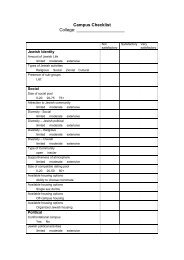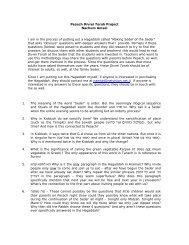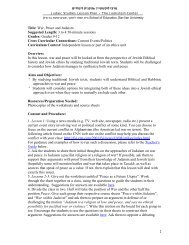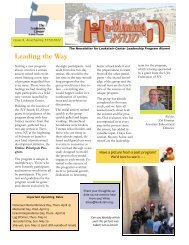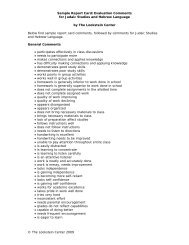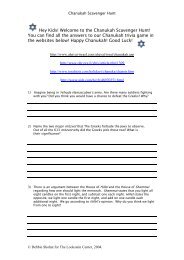FUNDAMENTAL CONCEPTS of the CLASSICAL HEBREW VERB
FUNDAMENTAL CONCEPTS of the CLASSICAL HEBREW VERB
FUNDAMENTAL CONCEPTS of the CLASSICAL HEBREW VERB
You also want an ePaper? Increase the reach of your titles
YUMPU automatically turns print PDFs into web optimized ePapers that Google loves.
(c) action X is relatively in <strong>the</strong> future. It is intended (has not yet commenced).<br />
‘I am about to eat’. This does not have a name, as it is <strong>of</strong>ten confused with <strong>the</strong> simple future,<br />
but it is not <strong>the</strong> same. The simple future ‘I will eat’ describes a simple future, but ‘I am about<br />
to eat’ describes <strong>the</strong> present state <strong>of</strong> affairs with regard to an action (X) in <strong>the</strong> future. For want<br />
<strong>of</strong> a better name, we may call it <strong>the</strong> intended tense. It is like <strong>the</strong> perfect only back to front in<br />
time.<br />
State <strong>of</strong> affairs (SA) in <strong>the</strong> past. Then (some time ago).<br />
(a) action X is relatively in <strong>the</strong> past. It was already completed.<br />
‘I had eaten’. This is called <strong>the</strong> pluperfect (or past perfect) tense. It describes <strong>the</strong> state <strong>of</strong><br />
affairs at some time in <strong>the</strong> past as a result <strong>of</strong> a previous (and already completed) action (X).<br />
(b) action X is relatively in <strong>the</strong> present. It was contemporary and continuous.<br />
‘I was eating’ (at <strong>the</strong> time). This is <strong>the</strong> past continuous tense. (It is <strong>of</strong>ten called <strong>the</strong> imperfect,<br />
but <strong>the</strong> same name, imperfect, is also used for <strong>the</strong> past repeated tense; this is because in<br />
French, Latin, German and o<strong>the</strong>r languages <strong>the</strong>y are <strong>the</strong> same, no distinction is made; but in<br />
English, and in Classical Hebrew, <strong>the</strong>y are not <strong>the</strong> same.)<br />
(c) action X is relatively in <strong>the</strong> future. It was intended, but had not yet commenced.<br />
‘I was about to eat’. This describes <strong>the</strong> state <strong>of</strong> affairs at some time in <strong>the</strong> past with regard to<br />
an intended action (X) that had not yet commenced. (Although this does not occur <strong>of</strong>ten, it<br />
does occur a few times in <strong>the</strong> Bible where it is very important. The action X may or may not<br />
subsequently have taken place - <strong>the</strong> point is that at <strong>the</strong> time it was intended.) This too has no<br />
name, but we could call it <strong>the</strong> past intended.<br />
State <strong>of</strong> affairs (SA) in <strong>the</strong> future. Then (ahead).<br />
(a) action X is relatively in <strong>the</strong> past. It will be completed.<br />
‘I will have eaten’. This is called <strong>the</strong> future perfect tense. It describes a state <strong>of</strong> affairs at some<br />
time in <strong>the</strong> future as a result <strong>of</strong> a previous (completed) action X.<br />
(b) action X is relatively in <strong>the</strong> present. It will be contemporary and continuous.<br />
‘I will be eating’ (e.g. when you arrive tomorrow). The future continuous tense.<br />
(c) action X is relatively in <strong>the</strong> future.<br />
‘I will be about to eat’. This is most unlikely to be ever used or needed, but is included here to<br />
complete <strong>the</strong> pattern.<br />
Action COMPLETED CURRENT INTENDED<br />
Background time<br />
In <strong>the</strong> past I had eaten I was eating I was about to eat<br />
In <strong>the</strong> present I have eaten I am eating I am about to eat<br />
In <strong>the</strong> future I will have eaten I will be eating (I will be about to eat)<br />
How does Classical Hebrew cope?<br />
This is just an overview, and we will explain in outline only how Hebrew copes.<br />
For <strong>the</strong> simple tenses, it uses <strong>the</strong> perfective aspect for a past action and <strong>the</strong> imperfective aspect for a future<br />
one. The word order (part <strong>of</strong> what we call <strong>the</strong> ‘syntax’) is important - <strong>the</strong> subject if any follows <strong>the</strong> verb.<br />
For <strong>the</strong> repeated tenses, it uses <strong>the</strong> imperfective aspect regardless <strong>of</strong> time, i.e. for past, present and future<br />
actions. Again <strong>the</strong> subject if any follows <strong>the</strong> verb. (Sometimes, for a present repeated tense, <strong>the</strong> participle is used<br />
instead - see later.)<br />
For <strong>the</strong> relative tenses, <strong>the</strong> imperfective or perfective aspects or <strong>the</strong> participle are used, as will be explained.<br />
The subject precedes <strong>the</strong> verb, and for an intended action an additional word may be needed..<br />
From <strong>the</strong> above it should already be clear that <strong>the</strong> aspects are not tenses, but are forms used, in conjunction<br />
with syntax, to form tenses in different ways.. In a later chapter we will take it all slowly and explain bit by bit<br />
how Hebrew copes. The mentality is different and not easy to absorb. In coping with tenses, we have now met<br />
four different mentalities, not just systems: <strong>the</strong> use <strong>of</strong> inflexion or conjugation alone with a limited number <strong>of</strong><br />
options (Latin, Greek, etc.); <strong>the</strong> use <strong>of</strong> auxiliaries with unlimited possibilities (English); <strong>the</strong> use <strong>of</strong> ‘time’ alone<br />
to replace tense (Aramaic, Modern Hebrew); and <strong>the</strong> ra<strong>the</strong>r complex system used by Classical Hebrew which<br />
involves a combination <strong>of</strong> inflexion and syntax (word order, use <strong>of</strong> special words etc.).



